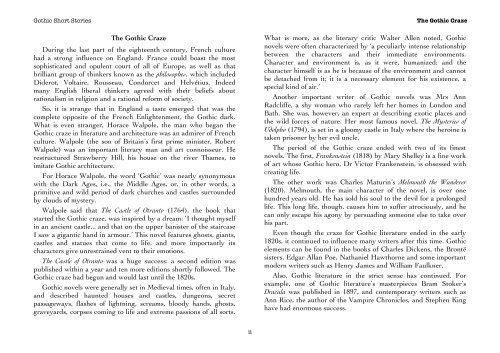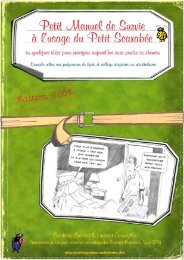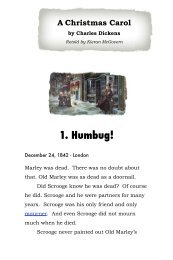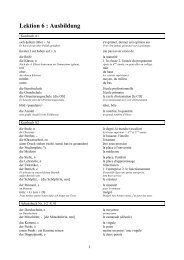The Gothic Craze During the last part of the eighteenth century ...
The Gothic Craze During the last part of the eighteenth century ...
The Gothic Craze During the last part of the eighteenth century ...
Create successful ePaper yourself
Turn your PDF publications into a flip-book with our unique Google optimized e-Paper software.
<strong>Gothic</strong> Short Stories <strong>The</strong> <strong>Gothic</strong> <strong>Craze</strong><br />
<strong>The</strong> <strong>Gothic</strong> <strong>Craze</strong><br />
<strong>During</strong> <strong>the</strong> <strong>last</strong> <strong>part</strong> <strong>of</strong> <strong>the</strong> <strong>eighteenth</strong> <strong>century</strong>, French culture<br />
had a strong influence on England. France could boast <strong>the</strong> most<br />
sophisticated and opulent court <strong>of</strong> all <strong>of</strong> Europe, as well as that<br />
brilliant group <strong>of</strong> thinkers known as <strong>the</strong> philosophes, which included<br />
Diderot, Voltaire, Rousseau, Condorcet and Helvétius. Indeed<br />
many English liberal thinkers agreed with <strong>the</strong>ir beliefs about<br />
rationalism in religion and a rational reform <strong>of</strong> society.<br />
So, it is strange that in England a taste emerged that was <strong>the</strong><br />
complete opposite <strong>of</strong> <strong>the</strong> French Enlightenment, <strong>the</strong> <strong>Gothic</strong> dark.<br />
What is even stranger, Horace Walpole, <strong>the</strong> man who began <strong>the</strong><br />
<strong>Gothic</strong> craze in literature and architecture was an admirer <strong>of</strong> French<br />
culture. Walpole (<strong>the</strong> son <strong>of</strong> Britain’s first prime minister, Robert<br />
Walpole) was an important literary man and art connoisseur. He<br />
restructured Strawberry Hill, his house on <strong>the</strong> river Thames, to<br />
imitate <strong>Gothic</strong> architecture.<br />
For Horace Walpole, <strong>the</strong> word ‘<strong>Gothic</strong>’ was nearly synonymous<br />
with <strong>the</strong> Dark Ages, i.e., <strong>the</strong> Middle Ages, or, in o<strong>the</strong>r words, a<br />
primitive and wild period <strong>of</strong> dark churches and castles surrounded<br />
by clouds <strong>of</strong> mystery.<br />
Walpole said that <strong>The</strong> Castle <strong>of</strong> Otranto (1764), <strong>the</strong> book that<br />
started <strong>the</strong> <strong>Gothic</strong> craze, was inspired by a dream: ‘I thought myself<br />
in an ancient castle... and that on <strong>the</strong> upper banister <strong>of</strong> <strong>the</strong> staircase<br />
I saw a gigantic hand in armour.’ This novel features ghosts, giants,<br />
castles and statues that come to life, and more importantly its<br />
characters give unrestrained vent to <strong>the</strong>ir emotions.<br />
<strong>The</strong> Castle <strong>of</strong> Otranto was a huge success: a second edition was<br />
published within a year and ten more editions shortly followed. <strong>The</strong><br />
<strong>Gothic</strong> craze had begun and would <strong>last</strong> until <strong>the</strong> 1820s.<br />
<strong>Gothic</strong> novels were generally set in Medieval times, <strong>of</strong>ten in Italy,<br />
and described haunted houses and castles, dungeons, secret<br />
passageways, flashes <strong>of</strong> lightning, screams, bloody hands, ghosts,<br />
graveyards, corpses coming to life and extreme passions <strong>of</strong> all sorts.<br />
ii<br />
What is more, as <strong>the</strong> literary critic Walter Allen noted, <strong>Gothic</strong><br />
novels were <strong>of</strong>ten characterized by ‘a peculiarly intense relationship<br />
between <strong>the</strong> characters and <strong>the</strong>ir immediate environments.<br />
Character and environment is, as it were, humanized; and <strong>the</strong><br />
character himself is as he is because <strong>of</strong> <strong>the</strong> environment and cannot<br />
be detached from it; it is a necessary element for his existence, a<br />
special kind <strong>of</strong> air.’<br />
Ano<strong>the</strong>r important writer <strong>of</strong> <strong>Gothic</strong> novels was Mrs Ann<br />
Radcliffe, a shy woman who rarely left her homes in London and<br />
Bath. She was, however, an expert at describing exotic places and<br />
<strong>the</strong> wild forces <strong>of</strong> nature. Her most famous novel, <strong>The</strong> Mysteries <strong>of</strong><br />
Udolpho (1794), is set in a gloomy castle in Italy where <strong>the</strong> heroine is<br />
taken prisoner by her evil uncle.<br />
<strong>The</strong> period <strong>of</strong> <strong>the</strong> <strong>Gothic</strong> craze ended with two <strong>of</strong> its finest<br />
novels. <strong>The</strong> first, Frankenstein (1818) by Mary Shelley is a fine work<br />
<strong>of</strong> art whose <strong>Gothic</strong> hero, Dr Victor Frankenstein, is obsessed with<br />
creating life.<br />
<strong>The</strong> o<strong>the</strong>r work was Charles Maturin’s Melmouth <strong>the</strong> Wanderer<br />
(1820). Melmouth, <strong>the</strong> main character <strong>of</strong> <strong>the</strong> novel, is over one<br />
hundred years old. He has sold his soul to <strong>the</strong> devil for a prolonged<br />
life. This long life, though, causes him to suffer atrociously, and he<br />
can only escape his agony by persuading someone else to take over<br />
his <strong>part</strong>.<br />
Even though <strong>the</strong> craze for <strong>Gothic</strong> literature ended in <strong>the</strong> early<br />
1820s, it continued to influence many writers after this time. <strong>Gothic</strong><br />
elements can be found in <strong>the</strong> books <strong>of</strong> Charles Dickens, <strong>the</strong> Brontë<br />
sisters, Edgar Allan Poe, Nathaniel Hawthorne and some important<br />
modern writers such as Henry James and William Faulkner.<br />
Also, <strong>Gothic</strong> literature in <strong>the</strong> strict sense has continued. For<br />
example, one <strong>of</strong> <strong>Gothic</strong> literature’s masterpieces Bram Stoker’s<br />
Dracula was published in 1897, and contemporary writers such as<br />
Ann Rice, <strong>the</strong> author <strong>of</strong> <strong>the</strong> Vampire Chronicles, and Stephen King<br />
have had enormous success.
<strong>Gothic</strong> Short Stories <strong>The</strong> <strong>Gothic</strong> <strong>Craze</strong><br />
Finally, we should note that all <strong>the</strong> conventions <strong>of</strong> <strong>Gothic</strong><br />
literature have entered <strong>the</strong> language <strong>of</strong> films. What filmgoer does<br />
not know what a creaking door in an old abandoned house during a<br />
thunder storm means (even if <strong>the</strong> house is located in <strong>the</strong> suburbs <strong>of</strong><br />
America)? In short, <strong>the</strong> <strong>Gothic</strong> craze continues.<br />
iii<br />
Answer <strong>the</strong> following questions.<br />
1. What did <strong>the</strong> word ‘<strong>Gothic</strong>’ mean for Horace Walpole?<br />
_________________________________________________________<br />
_________________________________________________________<br />
2. What were some <strong>of</strong> <strong>the</strong> common elements <strong>of</strong> <strong>Gothic</strong> novels?<br />
_________________________________________________________<br />
_________________________________________________________<br />
_________________________________________________________<br />
_________________________________________________________<br />
3. When did <strong>the</strong> <strong>Gothic</strong> craze begin?<br />
_________________________________________________________<br />
_________________________________________________________<br />
4. According to <strong>the</strong> critic Walter Allen, in <strong>Gothic</strong> novels what<br />
is <strong>of</strong>ten <strong>the</strong> relationship between characters and <strong>the</strong>ir<br />
environment?<br />
_________________________________________________________<br />
5. What was Dr Frankenstein’s obsession?<br />
_________________________________________________________<br />
6. Which contemporary writers have written successful<br />
<strong>Gothic</strong> novels?<br />
_________________________________________________________<br />
7. Why can we say that in a certain sense <strong>the</strong> <strong>Gothic</strong> craze<br />
continues to this day?<br />
_________________________________________________________<br />
_________________________________________________________









